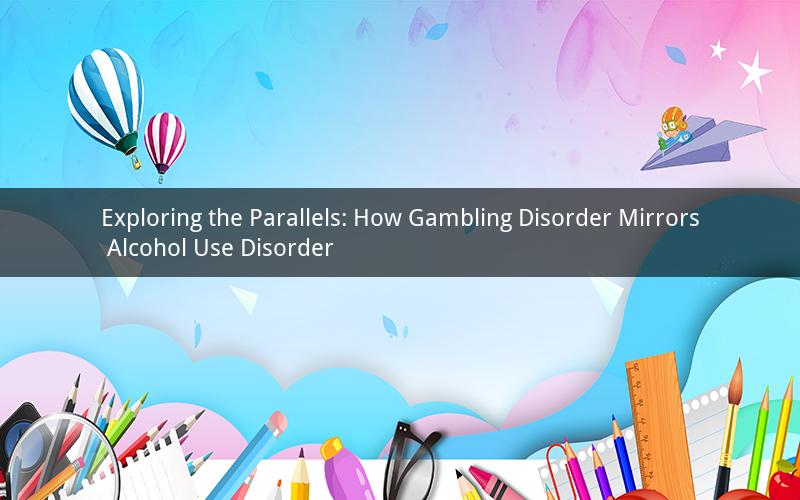
Gambling disorder and alcohol use disorder are two prevalent substance-related disorders that can significantly impact an individual's life. Although they involve different substances, these disorders share remarkable similarities in their onset, progression, and consequences. This article delves into the parallels between gambling disorder and alcohol use disorder, highlighting the underlying mechanisms, common risk factors, and potential treatment approaches.
Onset and Progression
Both gambling disorder and alcohol use disorder typically develop over time, starting with experimentation and progressing to more frequent and intense use. Individuals with gambling disorder may begin by trying their luck at a casino or placing a small bet, while those with alcohol use disorder might start with social drinking. As both disorders progress, the individual's need for the substance intensifies, leading to increased frequency, dose, and time spent on the activity.
Underlying Mechanisms
The neurobiological mechanisms underlying both gambling disorder and alcohol use disorder involve the reward system in the brain. When individuals engage in gambling or drinking, they experience a surge of dopamine, a neurotransmitter associated with pleasure and reward. Over time, the brain adapts to this increased dopamine levels, leading to tolerance and a decreased ability to experience pleasure without the substance.
Common Risk Factors
Several risk factors contribute to the development of both gambling disorder and alcohol use disorder. These include:
1. Genetic predisposition: Research indicates that both disorders have a genetic component, meaning individuals with a family history of either gambling or alcohol use are at a higher risk of developing the disorder themselves.
2. Environmental factors: Growing up in a household where substance use is prevalent or exposure to peer pressure can increase the risk of developing either disorder.
3. Personality traits: Individuals who are impulsive, have a low risk tolerance, or seek thrill and excitement may be more susceptible to both gambling and alcohol use disorders.
4. Psychological factors: Stress, anxiety, and depression can serve as triggers for both disorders, as individuals may turn to substances as a means of coping with these emotions.
Treatment Approaches
Both gambling disorder and alcohol use disorder require comprehensive treatment that addresses the underlying causes and consequences of the disorders. Common treatment approaches include:
1. Cognitive-behavioral therapy (CBT): CBT helps individuals recognize and change negative thought patterns and behaviors associated with their disorder. It can be particularly effective for gambling disorder and alcohol use disorder, as it focuses on identifying triggers and developing coping strategies.
2. Contingency management: This approach involves using rewards to encourage positive behaviors and penalties for negative behaviors. Contingency management can be effective for both gambling and alcohol use disorders, as it helps individuals develop healthier habits.
3. Medication: Certain medications can be used to treat the symptoms of both disorders. For example, naltrexone and disulfiram are used to reduce cravings and prevent relapse in alcohol use disorder, while medications such as naltrexone and topiramate have been studied for their potential in treating gambling disorder.
4. Support groups: Support groups, such as Gamblers Anonymous and Alcoholics Anonymous, provide individuals with a supportive environment to share their experiences and learn from others who have faced similar challenges.
5. Family therapy: Family therapy can help improve communication and strengthen relationships between individuals with gambling or alcohol use disorder and their family members. It can also address any co-occurring mental health issues that may be contributing to the disorder.
Frequently Asked Questions
1. Q: Can someone have both gambling disorder and alcohol use disorder at the same time?
A: Yes, it is possible for an individual to have both gambling disorder and alcohol use disorder simultaneously. This is known as dual diagnosis, and it requires a comprehensive treatment approach that addresses both disorders.
2. Q: How common is gambling disorder?
A: The prevalence of gambling disorder varies by country and population, but it is estimated that approximately 2-3% of the general population has a gambling disorder.
3. Q: Can someone develop a gambling disorder after only a few instances of gambling?
A: Yes, it is possible to develop a gambling disorder after a short period of time. The disorder can develop quickly, especially in individuals who are vulnerable to its effects.
4. Q: Are there any differences between gambling disorder and alcohol use disorder in terms of treatment?
A: While there are some similarities in treatment approaches, there are also differences. For example, specialized treatment programs may be available for individuals with gambling disorder, such as those that focus on cognitive-behavioral therapy or contingency management.
5. Q: Can gambling disorder lead to physical health issues?
A: Yes, gambling disorder can lead to various physical health issues, including heart disease, hypertension, and other stress-related conditions. Additionally, the negative consequences of gambling, such as financial and social problems, can also contribute to poor physical health.